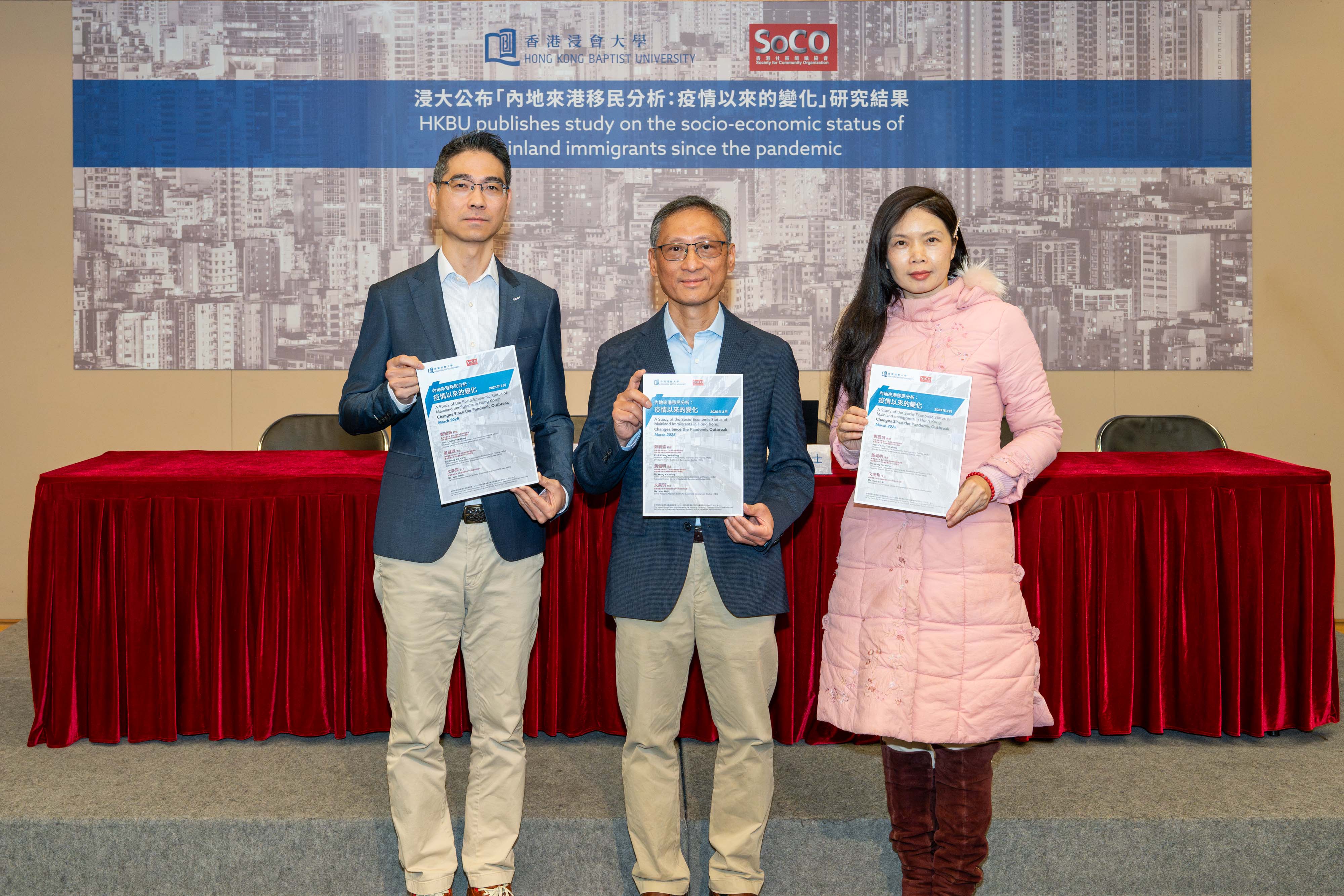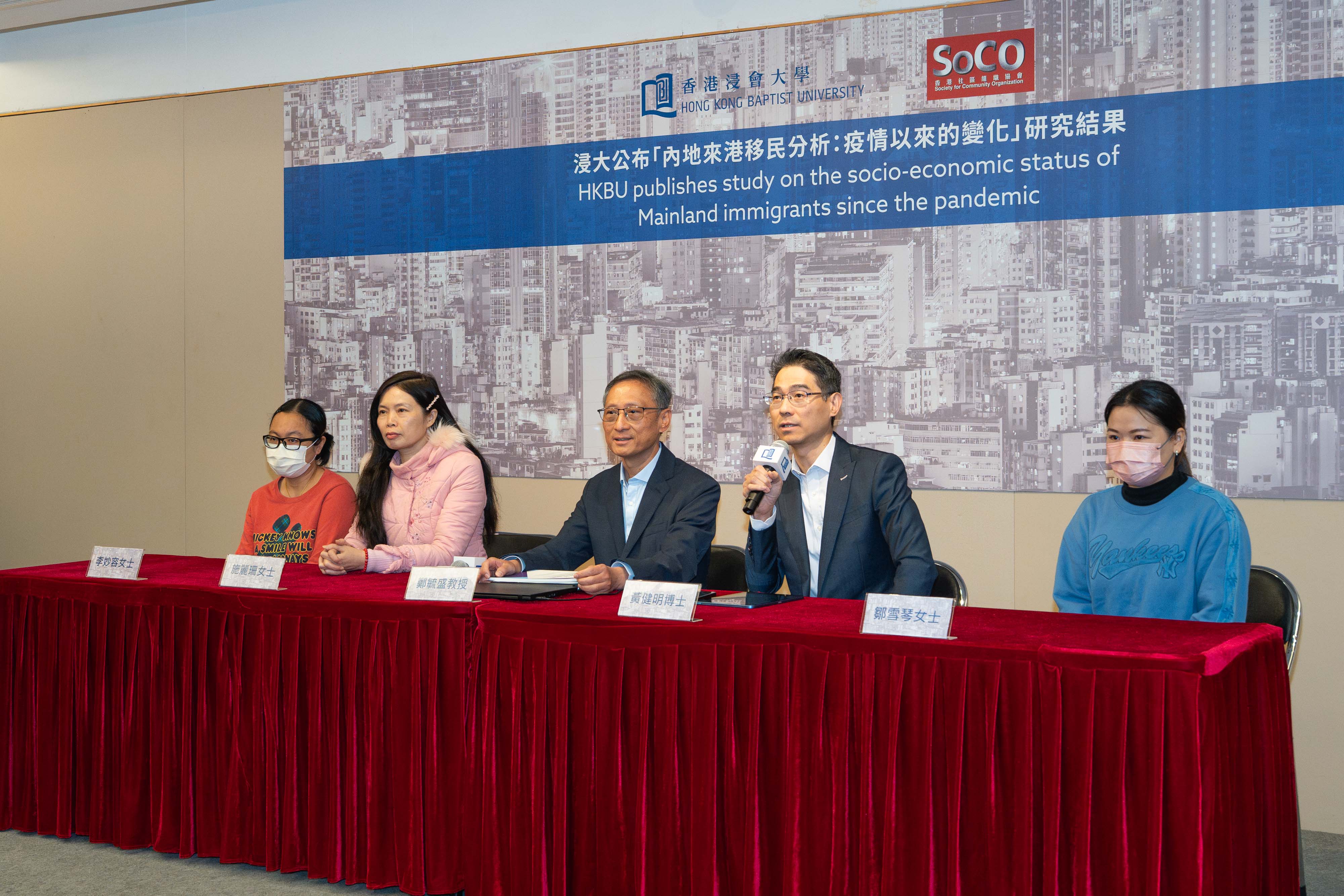Press Release
HKBU study reveals income still below pre-pandemic levels for 65% of low-income immigrants from Mainland
Thursday, 20 March 2025
The Centre for Sustainable Development Studies (CSDS) of the School of Business at Hong Kong Baptist University (HKBU) conducted a study on the socio-economic status of Mainland immigrants since the pandemic, which was commissioned by the Society for Community Organization (SoCO). HKBU, together with SoCO, announced the study results, revealing that among the grassroots Mainland immigrants who were employed in 2019, 65% were still earning a lower income in 2024 than in 2019, including 21% of those who were unemployed.
In addition, as of last year, more than half of the grassroot Mainland immigrants who were unemployed during the outbreak of COVID-19 had yet to find a job. Even though 15% of them returned to the labour market, their incomes were lower than that prior to the pandemic, revealing the prolonged impact brought about by the pandemic on the income level and employment rate of Mainland immigrants.
Professor Cheng Yuk-shing, Director of CSDS and Professor of the Department of Accountancy, Economics and Finance at HKBU; Dr Aries Wong Kin-ming, Associate Director (Knowledge Transfer) of CSDS and Senior Lecturer of the Department of Accountancy, Economics and Finance at HKBU; and the research team from CSDS, analysed the data obtained in the 2021 Population Census and the past, as well as the survey results of SoCO members, in an effort to investigate the impact of the COVID-19 pandemic on Mainland immigrants.
Income, employment rate fall below pre-pandemic level
Covering 3,236 Mainland immigrants who are SoCO members of working-age, researchers conducted analysis on their incomes and employment between 2019 and 2024. On a year-on-year comparison of income levels, their median income at the early stage of the pandemic in 2020 was HK$14,769 (at 2022 price level), a 4% decrease from 2019. The decline continued in 2021 and rebounded in 2022 and 2023. Meanwhile, it dropped again in 2024, recording a median income of HK$15,023 (at 2022 price level) in the first nine months, which is still 3% below the pre-pandemic level.
Tracking the unemployed cases since 2020, the research team discovered that more than half of them remained jobless in 2024, reflecting the “hysteresis unemployment” in economics, i.e. the short-term unemployment caused by a temporary economic downturn persists, resulting in a long-term unemployment. As for the other 15%, even if they returned to the job market, they were still earning an income below the pre-pandemic levels.
Class suspension affects employment of new immigrant mothers
With the class suspension during the pandemic, the employment of Mainland immigrant mothers had been particularly hard hit, given that they had to stay at home and take care of their children amid the lack of a comprehensive family network to support them. During the 2021 pandemic, the employment rate of Mainland immigrant mothers with children aged 6-15 dropped from 39% in 2016 to 30%, marking a significant decrease of 9 percentage points, which is three times the decrease in the employment rate of mothers who are locally born.
Late arrival immigrants in Hong Kong have lower academic qualifications
The study reveals that Mainland students who arrive in Hong Kong at a later stage in life have a lower rate of attaining a bachelor’s degree or higher qualification. According to the 2021 Population Census data, the percentages of Mainland immigrants aged 25-29 who arrived in Hong Kong at kindergarten, primary and secondary levels with a bachelor’s degree or above were 44%, 38% and 34% respectively, reflecting those who came to Hong Kong at an early age had more time to adapt to the local education system.
The study points out that the pandemic has delayed the arrival of primary and secondary school-age children from the Mainland, which may affect their chances of pursuing university education in the long run. According to the statistics of the Education Bureau, the number of Mainland students enrolled in local primary and secondary schools for the first time dipped from an annual average of 7,951 in 2018-2019 to 3,832 in 2020-2022.
Mainland immigrants help ease ageing population
According to the data in 2021, the median age of Mainland immigrants arriving in Hong Kong over the past two decades was 39.6, lower than that of the overall population of Hong Kong at 47.3. Together with the fact that they have given birth to children in Hong Kong, the Mainland immigrants have helped alleviate the ageing problem in the city. Meanwhile, if there were no Mainland immigrants coming to Hong Kong, the children and youth population in 2021 would have plummeted by 20%, showing the Mainland immigrants are an integral part of the labour force, and that the median age of the population would have climbed to 49.6.
During the pandemic, those working in the healthcare sector accounted for 5.9% of the total employed population in Hong Kong in 2021, up from 4.8% in 2016. The increase showcased the strong demand for labour in the healthcare sector driven by the pandemic. Over the same period, the proportion of Mainland female immigrants with low education levels employed in the healthcare sector surged by 44%, and their proportion in the overall employed population in the healthcare sector also rose by 11%, a demonstration of Mainland immigrants replenishing Hong Kong’s labour force.
Labour force participation rates, income levels and poverty rates improve with years of residence
Compared with residents who were born in Hong Kong, Mainland immigrants have lower labour force participation rates and income levels, and higher poverty rates when they arrived in Hong Kong. However, as the Mainland immigrants have resided in Hong Kong for a longer time, the gap among all three indicators have gradually closed.
Background of Mainland new arrivals becomes more diversified
The increase in the number of entry routes to Hong Kong has led to the diversification of the backgrounds of new arrivals from the Mainland. Traditionally, most Mainland immigrants came to Hong Kong on one-way permits (OWPs) for family reunion, but in recent years, an increasing number of Mainland residents have arrived in Hong Kong on non-OWPs. There is a significant difference in the backgrounds of these groups, with notable differentiation in their selections of occupations and industries. Mainland immigrants coming to Hong Kong on OWPs are more likely to be engaged in traditional industries, while those on non-OWPs are more likely to be engaged in finance, insurance and professional services.
Policy recommendations on Mainland immigrants
Professor Cheng Yuk-shing remarked that the study results reflected the worrying long-term, rather than short-term impact of the pandemic on low-income Mainland immigrants. He said, “Apart from providing short-term assistance to meet their immediate needs, measures targeted to help the relevant groups to return to the job market will be effective in ameliorating the poverty problem in Hong Kong.”
Dr Aries Wong said that the class suspension during the pandemic had dealt a heavy blow on the employment of new immigrant mothers. The society should consider how to introduce measures to support Mainland immigrant mothers in seeking employment, such as allocating more resources in schools and the community to support parents in childcare.
The research team also recommended that when formulating its population and manpower policies, the Government should fully consider the impact of Mainland immigrants on Hong Kong’s demographic structure and labour force in future.
Ms Sze Lai-shan, Deputy Director of SoCO, said that the findings echoed the observations of SoCO. New immigrant families encounter a lot of problems when they first arrive in Hong Kong. Apart from having to take care of their children, they also face greater difficulties than local residents due to inadequate childcare services and weak social networks. However, as long as they are open to learning and the community provides support, new immigrants who endeavour to find a way out can stay out of poverty.
For the report on “A Study of the Socio-Economic Status of Mainland Immigrants in Hong Kong: Changes Since the Pandemic Outbreak”, please go to https://csds.hkbu.edu.hk/CSDS-Event1/CSDS-SoCO-Report-2025.html.

